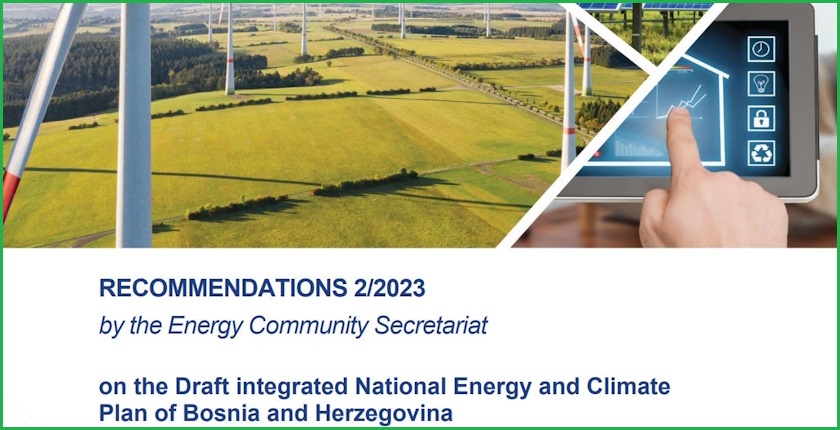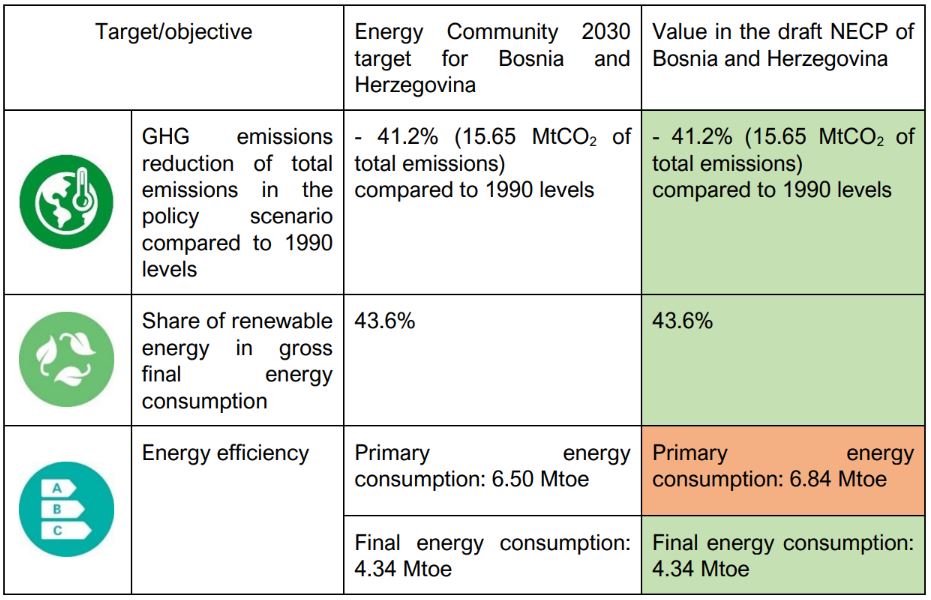
Photo: Energy Community
Bosnia and Herzegovina’s draft National Energy and Climate Plan (NECP) lacks an analytical basis, clear set of policies and measures, description of investment needs, and an assessment of the impacts of the planned policies and investments, the Energy Community Secretariat said in its recommendations.
The Ministry of Foreign Trade and Economic Relations of BiH submitted its draft National Energy and Climate Plan to the secretariat for its review on June 30, within the legal deadline. It did not include a strategic environmental assessment report.
“BiH’s draft NECP lacks the analytical basis, which is essential for the necessary overview of the country’s planned path towards achieving its 2030 targets in GHG emission reduction, renewable energy and energy efficiency. The NECP would also benefit from a more concrete formulation of policies and measures reflecting the precise actions that the authorities of BiH are planning to take to facilitate the green transition,” the secretariat said.
The secretariat called on BiH to bring its 2030 energy efficiency targets (maximum level of primary energy consumption) in line with the Energy Community’s objectives.
Here are the main takeaways from the secretariat’s recommendations. Of note, in November 2023 the Secretariat issued recommendations for Serbia’s NECP.
Decarbonization – no coal phaseout date
Non-energy sectors such as agriculture, waste and industrial processes and product use are missing sectoral targets and policies and measures (PaMs).
The large combustion plant dimension of the draft NECP is not elaborated in detail and requires substantial improvement. There is only one brief reference to the National Emission Reduction Plan (NERP), the implementation alternative chosen by BiH to comply with the Large Combustion Plants Directive, which the country is breaching from 2018 onwards.
There is only a single measure related to the just transition
The draft NECP also unlawfully considers the plants that were subject to the opt-out mechanism, Tuzla 4 and Kakanj 5, which should have been closed already because they have reached the 20,000-hour limit.
There is only a single measure related to the just transition and it includes the implementation of a roadmap for the transition of coal-rich regions in BiH until 2025. According to the secretariat, it is not clear which roadmap the document refers to.
Moreover, considering the role of coal in the energy sector, BiH needs to clearly indicate the planned actions going beyond 2025, aiming at the support of regions for a successful management of the transition, the secretariat said.
The draft focuses on setting up a national ETS without considering the assessment of a regional or European perspective
The draft plan does not indicate any phaseout date for coal for electricity generation or on the level of the general economy, even though it refers to the overall objective of carbon neutrality by 2050.
The document includes a policy and measure regarding the establishment and functioning of a CO2 emission trading system with a 2026 deadline.
However, it focuses on setting up a national emissions trading system without considering an assessment of a regional or European perspective, and lacks details, for instance on the sectoral scope, allocation methodologies and other essential building blocks.
Renewables – a 4.4-fold increase for wind and a 14.6-fold increase for solar

The overall 2030 renewable energy target is divided into sectoral targets for electricity (70.1%), transport (8.4%), and heating and cooling (60.8%).
The plan foresees a significant increase in wind power capacity, from 135 MW in 2022 to 600 MW, and an increase in solar power capacity from 102 MW to 1,492 MW. The planned expansion represents approximately a 4.4-fold increase for wind power and a 14.6-fold increase for solar power, requiring areas that can accommodate the deployment of renewable energy projects.
The target of 70.1% by 2030 is ambitious
A study by the International Renewable Energy Agency called Renewable Energy Prospects for Central and South-Eastern Europe Energy Connectivity (CESEC) indicates that BiH possesses almost twice the potential to cost-efficiently harness onshore wind for electricity generation by 2030 compared to what is proposed in the draft NECP (1.03 GW compared to 0.6 GW), according to the secretariat.
The suggested capacities for harnessing solar PV in the draft NECP align with the findings of the study (1.49 GW).
Considering that renewable energy accounted for 46.32% of electricity consumption in 2021, achieving a target of 70.1% by 2030 appears ambitious, the secretariat stressed.
Energy efficiency – BiH must increase its target
The 2030 energy efficiency targets outlined in the draft NECP are 6.84 megatons of oil equivalent in maximum primary energy use and 4.34 megatons in maximum final energy use.
Achieving the goals is legally binding for BiH under a Ministerial Council decision requiring the country to pursue the same level of ambition – a maximum of 6.5 megatons instead of 6.84 megatons of oil equivalent – for 2030, the secretariat pointed out.
The policies and measures in the draft do not provide explanations or examples of how the energy-efficiency-first principle was taken into account.
Energy security – lack of regional cooperation and dimension
The draft plan lacks an explanation of the strategic priorities or any quantified targets and objectives, such as diversification, in the field of energy security.
Concerning targets and objectives, the draft plan recognizes the necessity to diversify supply routes of oil and natural gas, but inaccurately assumes the same need in the electricity sector, which is already well interconnected.
The draft focuses on diversifying energy sources and supply from third countries but lacks consideration of the regional cooperation and regional dimension, which could significantly decrease the energy transition costs, the secretariat stressed.
Internal energy market – the Electricity Integration Package isn’t addressed properly
The draft NECP doesn’t take full account of the Electricity Integration Package, but only touches upon a very limited number of its requirements. The package was supposed to be transposed and implemented by December 31, 2023.
Regarding flexibility in the electricity system, more reserves are planned to appear on the consumers’ side, but there is no analytical explanation for such an assumption or any concrete targets for demand response or consumer participation.
The plan doesn’t include an analysis of energy poverty reduction
The long-term transmission network development plan 2021-2030 of the state-owned transmission company Elektroprenos-Elektroprijenos BiH is based on the indicative production development plan prepared by the national transmission system operator NOSBiH, but not adjusted to the draft NECP, and it also doesn’t consider different scenarios of renewables integration.
The draft addresses energy poverty but currently there is neither a definition of energy poverty nor a clear methodology or implemented indicators to measure energy poverty.
The plan doesn’t include an analysis of energy poverty reduction, the secretariat said in its recommendations on BiH’s draft NECP.


















Be the first one to comment on this article.